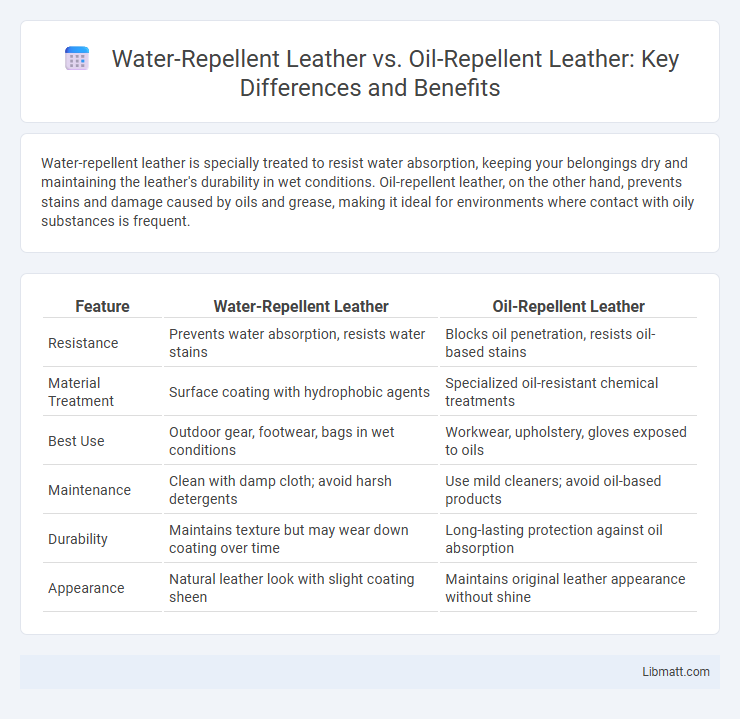Water-repellent leather is specially treated to resist water absorption, keeping your belongings dry and maintaining the leather's durability in wet conditions. Oil-repellent leather, on the other hand, prevents stains and damage caused by oils and grease, making it ideal for environments where contact with oily substances is frequent.
Table of Comparison
| Feature | Water-Repellent Leather | Oil-Repellent Leather |
|---|---|---|
| Resistance | Prevents water absorption, resists water stains | Blocks oil penetration, resists oil-based stains |
| Material Treatment | Surface coating with hydrophobic agents | Specialized oil-resistant chemical treatments |
| Best Use | Outdoor gear, footwear, bags in wet conditions | Workwear, upholstery, gloves exposed to oils |
| Maintenance | Clean with damp cloth; avoid harsh detergents | Use mild cleaners; avoid oil-based products |
| Durability | Maintains texture but may wear down coating over time | Long-lasting protection against oil absorption |
| Appearance | Natural leather look with slight coating sheen | Maintains original leather appearance without shine |
Introduction to Water-Repellent and Oil-Repellent Leather
Water-repellent leather is treated with specialized coatings that prevent water absorption, enhancing durability and maintaining breathability for everyday use. Oil-repellent leather incorporates advanced surface treatments designed to resist oily stains and spills, preserving the leather's appearance and extending its lifespan. Both water-repellent and oil-repellent leathers utilize cutting-edge technologies to provide protection against liquid damage while retaining the leather's natural texture and flexibility.
How Water-Repellent Leather Works
Water-repellent leather is treated with special coatings or finishes that create a microscopic barrier, preventing water molecules from penetrating the leather fibers while allowing them to breathe. This treatment uses hydrophobic substances, such as silicone or fluoropolymer, to repel water effectively and maintain the leather's natural flexibility and appearance. Your leather products stay protected from moisture damage without compromising comfort or durability.
Mechanisms Behind Oil-Repellent Leather
Oil-repellent leather is engineered using specialized surface treatments that create a low surface energy barrier, preventing oils from penetrating the material. This is achieved through fluorochemical or silicone-based coatings that repel oil molecules by disrupting their adhesion to the leather fibers. Your choice of oil-repellent leather ensures enhanced durability and stain resistance compared to water-repellent varieties, which primarily focus on preventing water absorption rather than oily substances.
Key Differences: Water-Repellent vs Oil-Repellent Leather
Water-repellent leather is specially treated to resist moisture and prevent water absorption, making it ideal for wet conditions, while oil-repellent leather is engineered to repel oils and grease, protecting the material from stains and damage caused by oily substances. The key difference lies in their specialized coatings: water-repellent leather uses hydrophobic treatments, whereas oil-repellent leather employs oleophobic finishes to maintain durability and appearance. Understanding these distinctions helps you choose the right leather type for specific environmental challenges and maintenance needs.
Materials and Treatments Used for Repellency
Water-repellent leather is typically treated with hydrophobic coatings such as fluoropolymers or silicone-based treatments that create a barrier against moisture. Oil-repellent leather, on the other hand, undergoes specialized treatments using oleophobic substances like perfluorinated compounds to prevent oil absorption without compromising the leather's breathability. Your choice should consider the type of exposure, as water-repellent leathers excel in wet conditions, while oil-repellent leathers are better suited for environments prone to greasy substances.
Durability and Longevity Comparison
Water-repellent leather typically features a protective coating that resists moisture but may wear off over time, reducing its effectiveness and requiring periodic reapplication to maintain durability. Oil-repellent leather is treated with specialized finishes that prevent oil absorption, preserving the leather's texture and strength longer under oily or greasy conditions. Overall, oil-repellent leather tends to offer greater longevity in environments with frequent oil exposure, while water-repellent leather excels in wet conditions but may require more maintenance to sustain its protective qualities.
Best Uses for Water-Repellent Leather
Water-repellent leather is ideal for outdoor gear, footwear, and accessories exposed to rain and moisture, ensuring durability and comfort in wet conditions. This type of leather excels in environments where quick water shedding is crucial, such as hiking boots and jackets. Its coating prevents water absorption without compromising breathability, making it suitable for everyday wear in rainy climates.
Best Applications for Oil-Repellent Leather
Oil-repellent leather is ideal for industries where exposure to grease, oils, and chemical substances is frequent, such as automotive interiors, industrial workwear, and high-performance footwear. Its specialized coating resists oil penetration, preventing stains and maintaining leather integrity in harsh environments. This type of leather is preferred in settings requiring durable, easy-to-clean materials that preserve appearance despite regular contact with oily substances.
Maintenance and Cleaning Tips
Water-repellent leather requires gentle cleaning with a damp cloth and occasional reapplication of a specialized water-resistant spray to maintain its protective layer. Oil-repellent leather benefits from using a mild detergent specifically designed for removing oil-based stains without stripping the finish, and it's essential to avoid harsh chemicals that can degrade its repellency. Your leather's durability improves significantly when proper maintenance routines are followed according to its treatment type.
Choosing the Right Leather for Your Needs
Water-repellent leather is designed to resist moisture penetration, making it ideal for environments where exposure to rain or humidity is common, while oil-repellent leather is treated to repel oils and stains, providing better protection against grease and dirt. Your choice depends on the primary conditions your leather goods will face; water-repellent leather suits outdoor and wet conditions, whereas oil-repellent leather is preferable for settings where contact with oily substances is frequent. Understanding the specific resistance properties of each type ensures that you select leather that maintains durability and appearance under your typical usage.
Water-repellent leather vs oil-repellent leather Infographic

 libmatt.com
libmatt.com